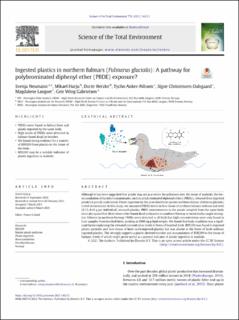| dc.contributor.author | Neumann, Svenja | |
| dc.contributor.author | Harju, Mikael | |
| dc.contributor.author | Herzke, Dorte | |
| dc.contributor.author | Anker-Nilssen, Tycho | |
| dc.contributor.author | Christensen-Dalsgaard, Signe | |
| dc.contributor.author | Langset, Magdalene | |
| dc.contributor.author | Gabrielsen, Geir W. | |
| dc.date.accessioned | 2021-08-31T11:35:56Z | |
| dc.date.available | 2021-08-31T11:35:56Z | |
| dc.date.created | 2021-03-15T12:21:36Z | |
| dc.date.issued | 2021 | |
| dc.identifier.citation | Science of the Total Environment. 2021, 778, 146313. | en_US |
| dc.identifier.issn | 0048-9697 | |
| dc.identifier.uri | https://hdl.handle.net/11250/2771951 | |
| dc.description.abstract | Although it has been suggested that plastic may act as a vector for pollutants into the tissue of seabirds, the bioaccumulation of harmful contaminants, such as polybrominated diphenyl ethers (PBDEs), released from ingested plastics is poorly understood. Plastic ingestion by the procellariiform species northern fulmar (Fulmarus glacialis) is well documented. In this study, we measured PBDEs levels in liver tissue of northern fulmars without and with (0.13–0.43 g per individual) stomach plastics. PBDE concentrations in the plastic sampled from the same birds were also quantified. Birds were either found dead on beaches in southern Norway or incidentally caught in longline fisheries in northern Norway. PBDEs were detected in all birds but high concentrations were only found in liver samples from beached birds, peaking at 2900 ng/g lipid weight. We found that body condition was a significant factor explaining the elevated concentration levels in livers of beached birds. BDE209 was found in ingested plastic particles and liver tissue of birds with ingested plastics but was absent in the livers of birds without ingested plastics. This strongly suggests a plastic-derived transfer and accumulation of BDE209 to the tissue of fulmars, levels of which might prove useful as a general indicator of plastic ingestion in seabirds. | en_US |
| dc.language.iso | eng | en_US |
| dc.rights | Navngivelse 4.0 Internasjonal | * |
| dc.rights.uri | http://creativecommons.org/licenses/by/4.0/deed.no | * |
| dc.title | Ingested plastics in northern fulmars (Fulmarus glacialis): A pathway for polybrominated diphenyl ether (PBDE) exposure? | en_US |
| dc.type | Peer reviewed | en_US |
| dc.type | Journal article | en_US |
| dc.description.version | publishedVersion | en_US |
| dc.rights.holder | © 2021 The Authors. Published by Elsevier B.V. | en_US |
| dc.source.volume | 778 | en_US |
| dc.source.journal | Science of the Total Environment | en_US |
| dc.identifier.doi | 10.1016/j.scitotenv.2021.146313 | |
| dc.identifier.cristin | 1898095 | |
| dc.relation.project | NILU: 119058 | en_US |
| dc.source.articlenumber | 146313 | en_US |
| cristin.ispublished | true | |
| cristin.fulltext | original | |
| cristin.qualitycode | 2 | |

